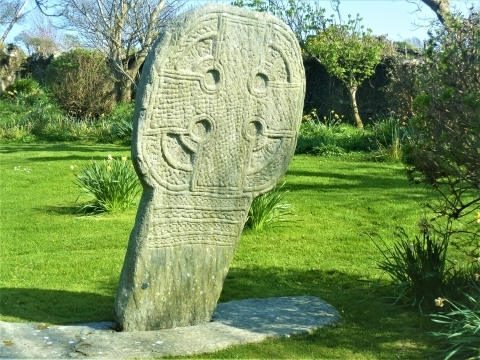Celtic Cross at St Adamnan's Church, Lonan, Isle of Man

Standing on its original site in the churchyard of St Adamnan's Church in the Parish of Lonan (Manx Gaelic: Skyll Lonan) on the Isle of Man (Mannin) is a very beautiful Celtic Cross. It is one of a number of Celtic Crosses in the churchyard that date back to the 5th century. One of the early Keeils (a Manx Gaelic word for a church), St Adamnan's Church is on the site of an earlier keeill dating from the 5th century. Often simply referred to as "Lonan Old Church" it was originally known in Manx as Keeill ny-Traie, or "the chapel by the shore" and is on the eastern side of the Island. The church is dedicated to St Adamnan who was born in Ireland. Adomnán or Adamnán of Iona (c. 624 – 704), was an abbot of Iona Abbey on the west coast of Scotland.
The Celtic cross in the churchyard is considered one of the most important and significant crosses on the island. It stands 5 feet high and is a magnificent example of interlaced Celtic knot and plait work. It has a large equal-limbed Celtic wheel-head cross and the carving, even after many centuries of exposure to the elements, is still clear. The cross, the back of which is uncarved, has begun to lean, but is still attached firmly to its base. The other ancient cross and slab fragments that are preserved within the Lonan churchyard are housed in a covered shelter. Many of the Island's other churchyards and churches house displays of ancient stone crosses found within the parishes of their origin.
Since the 5th Century AD, crosses have been used in the Isle of Man as memorials and gravestones. Many, such as those in the churchyard of St Adamnan's are entirely Celtic, with Celtic inscriptions in the written language of Ogham to commemorate the dead. When the Vikings later came to the island, they brought with them their own sculptors. Even after their conversion to Christianity these stones often incorporated images from Norse pagan mythology, whilst incorporating Christian symbols. It is thought that the significant number of Norse runestone that have survived on the Island, owes much to the shared Norse and Celtic tradition of raising high crosses. Some have Norse Runic inscriptions and Ogham inscriptions on the same stone. The clear evidence is that the Norse who settled on the Isle of Man were assimilated into the native population and eventually spoke their Gaelic language.
In addition to the Celtic Crosses, today's St Adamnan's Church in Lonan is a very interesting place to visit. It is in two parts. One section has the derelict and roofless remains of a twelfth century keeil, built over a previous one. This is attached to a newer building possibly dating in parts to the 13th century. There was a period when St Adamnan's fell into disrepair, but was restored by the Reverend John Quine, who became vicar of Lonan in 1895. The Friends of St Adamnan's were formed in 1968 to keep the old church in good repair and ensure it remained as a working church and historical site.
Image: Lonan Celtic Cross.






